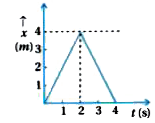A cricket ball of mass 150 g has an initial velocity and a final velocity , after being hit. The change in momentum (final momentuminitial momentum) is (in )Solution in Gujrati
zero
The correct Answer is:C
( c)
Given initial velocity
Final velocity v = -
Now change in momentum
= Final momentum - initial momentum
Topper's Solved these Questions
- BOOK - KUMAR PRAKASHANCHAPTER - LAW OF MOTIONEXERCISE - SECTION -E(MULTIPLE CHOICE QUESTIONS) (MCQS)69videos
LAW OF MOTION
- BOOK - KUMAR PRAKASHANCHAPTER - LAW OF MOTIONEXERCISE - SECTION-F (QUESTIONS FROM MODULE)22videos
LAW OF MOTION
- BOOK - KUMAR PRAKASHANCHAPTER - LAW OF MOTIONEXERCISE - SECTION-C(OBJECTIVE QUESTIONS) (VSQS)55videos
LAW OF MOTION
- BOOK - KUMAR PRAKASHANCHAPTER - GRAVITATIONEXERCISE - QUESTIONS PAPER Section - D1videos
GRAVITATION
- BOOK - KUMAR PRAKASHANCHAPTER - MACHANICAL PROPERTIES OF SOLIDS EXERCISE - QUESTION PAPER11videos
MACHANICAL PROPERTIES OF SOLIDS
Similar Questions
The position (x) → time (t) graph of one dimensional motion of a body of mass 0.4 kg. What is the magnitude of impulse of force
 02:29View Solution
02:29View SolutionA block rests on a rough inclined plane making an angle of 30° with the horizontal. The coefficient of static friction between the block and the plane is 0.8. If the frictional force on the block is 10 N, the mass of the block ((in kg) is .......... (Take g = 10 m/s2)
01:27View SolutionArea of F → t graph gives which physical quantity ?
01:44View SolutionA spaceship is stationed on Mars. How much energy must be expended on the spaceship to launch it out of the solar system ? Mass of the spaceship = 1000 kg, mass of the sun =2×1030kg, mass of mars =6.4×1023kg, radius of mars = 3395 km, radius of the orbit of mars =2.28×108km,G=6.67×10−11Nm2kg2
01:43View SolutionWhat is called brittle material ?
03:36View SolutionA cricket ball of mass 150g has an initial velocity (3ˆi+4ˆj)ms−1 and a final velocity υ=−(3ˆi+4ˆj)ms−1 after beigh hit The change in momentum (final momentum initial momentum) is (in kg ms−1)
03:36View SolutionA cricket ball of mass 150 g has an intial velocity u = (3ˆi+4ˆj)ms−1 and a final velocity v=−(3ˆi+4ˆj)ms−1 , after being hit. The change in momentum (final momentum - initial momentum ) is (in Kgms1)
02:29View SolutionA cricket ball of mass 150 g has an initial velocity ¯u=(3ˆi−4ˆj)ms−1 and a final velocity ¯v=−(3ˆi−4ˆj)ms−1 after being hit. The change in momentum (final momentum -initial momentum) is (in kg ms−1)
03:15View SolutionA ball weighing 150g is moving with an initial velocity¯u=(3∧i+4∧j)ms−1 After being hit by the player its final velocity is ¯u=(3∧i+4∧j)ms−1What is the magnitude of change in momentam in kg ms−1
05:04View Solution150 ग्राम द्रव्यमान की एक क्रिकेट गेंद का प्रारंभिक वेग ˆu=(3ˆi+4ˆj) मीटर/सेकण्ड तथा प्रहार (Hit) होने के पश्चात अंतिम वेग →v=(−3ˆi+4ˆj) मी/सेकण्ड है। संवेग में परिवर्तन (अंतिम संवेग - प्रारंभिक संवेग) होगा (किग्रा मी/सेकण्ड में) -
01:20View SolutionInitial velocity of a cricket ball of mass 150 grams u = (3hati+4hatj) M / s and final velocity after hit v=-(3hati+4hatj) M / s. The momentum change of the ball is in kg-m / s
02:15View SolutionA cricket ball of mass 150 g has an intial velocity u = (3 hati + 4 hatj)ms^(-1) and a final velocity v = -(3hati + 4 hatj) ms^(-1) , after being hit. The change in momentum (final momentum - initial momentum ) is (in Kg ms^(1) )
01:52View SolutionA cricket ball of mass 150 g has an initial velocity bar(u)=(3hati-4hatj)ms^(-1) and a final velocity bar(v)=-(3hati-4hatj)ms^(-1) after being hit. The change in momentum (final momentum -initial momentum) is ("in kg ms"^(-1))
02:50View Solution150 g द्रव्यमान की किसी क्रिकेट की गेंद का प्रारम्भिक वेग u=(3ˆi+4ˆj)ms−1 और हिट होने के बाद अंतिम वेग v=−(3ˆi+4ˆj)ms−1 है। गेंद का संवेग परिवर्तन kgms−1 है -
03:36View SolutionA cricket ball of mass 100g has initial velocity vec u = (3hati + 4hatj)ms and final velocity vec v = (-3hati -4hatj)ms after being hit by the bat.The magnitude of the impulse on the bat by the ball will be
02:59View Solution

